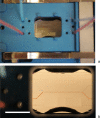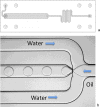Lab-on-a-Chip: Frontier Science in the Classroom
- PMID: 30258250
- PMCID: PMC6150665
- DOI: 10.1021/acs.jchemed.7b00506
Lab-on-a-Chip: Frontier Science in the Classroom
Abstract
Lab-on-a-chip technology is brought into the classroom through development of a lesson series with hands-on practicals. Students can discover the principles of microfluidics with different practicals covering laminar flow, micromixing, and droplet generation, as well as trapping and counting beads. A quite affordable novel production technique using scissor-cut and laser-cut lamination sheets is presented, which provides good insight into how scientific lab-on-a-chip devices are produced. In this way high school students can now produce lab-on-a-chip devices using lamination sheets and their own lab-on-a-chip design. We begin with a review of previous reports on the use of lab-on-a-chip technology in classrooms, followed by an overview of the practicals and projects we have developed with student safety in mind. We conclude with an educational scenario and some initial promising results for student learning outcomes.
Conflict of interest statement
The authors declare no competing financial interest.
Figures








Similar articles
-
Student-led microfluidics lab practicals: Improving engagement and learning outcomes.Biomicrofluidics. 2016 Jun 8;10(3):034117. doi: 10.1063/1.4953448. eCollection 2016 May. Biomicrofluidics. 2016. PMID: 27375822 Free PMC article.
-
Lab on a chip technologies for algae detection: a review.J Biophotonics. 2012 Aug;5(8-9):661-72. doi: 10.1002/jbio.201200051. Epub 2012 Jun 13. J Biophotonics. 2012. PMID: 22693123 Review.
-
Design, fabrication and characterization of drug delivery systems based on lab-on-a-chip technology.Adv Drug Deliv Rev. 2013 Nov;65(11-12):1403-19. doi: 10.1016/j.addr.2013.05.008. Epub 2013 May 29. Adv Drug Deliv Rev. 2013. PMID: 23726943 Review.
-
Should laptops be allowed in the classroom? Two viewpoints: viewpoint 1: laptops in classrooms facilitate curricular advancement and promote student learning and viewpoint 2: deconstructing and rethinking the use of laptops in the classroom.J Dent Educ. 2014 Dec;78(12):1580-8. J Dent Educ. 2014. PMID: 25480272
-
BioMEMS and Lab-on-a-Chip Course Education at West Virginia University.Biosensors (Basel). 2011 Jan 20;1(1):4-12. doi: 10.3390/bios1010004. Biosensors (Basel). 2011. PMID: 25586697 Free PMC article.
Cited by
-
"Learning on a chip:" Microfluidics for formal and informal science education.Biomicrofluidics. 2019 Jul 9;13(4):041501. doi: 10.1063/1.5096030. eCollection 2019 Jul. Biomicrofluidics. 2019. PMID: 31431815 Free PMC article. Review.
-
Modular Science Kit as a support platform for STEM learning in primary and secondary school.J Chem Educ. 2021 Feb 9;98(2):439-444. doi: 10.1021/acs.jchemed.0c01115. Epub 2020 Dec 16. J Chem Educ. 2021. PMID: 33583951 Free PMC article.
-
An interdisciplinary and application-oriented approach to teach microfluidics.Biomicrofluidics. 2021 Jan 22;15(1):014104. doi: 10.1063/5.0038389. eCollection 2021 Jan. Biomicrofluidics. 2021. PMID: 33537111 Free PMC article.
-
An economical in-class sticker microfluidic activity develops student expertise in microscale physics and device manufacturing.Lab Chip. 2024 Apr 16;24(8):2176-2192. doi: 10.1039/d3lc00912b. Lab Chip. 2024. PMID: 38328814 Free PMC article.
-
Open-loop lab-on-a-chip technology enables remote computer science training in Latinx life sciences students.bioRxiv [Preprint]. 2023 May 1:2023.04.28.538776. doi: 10.1101/2023.04.28.538776. bioRxiv. 2023. Update in: Sci Rep. 2024 Jun 22;14(1):14364. doi: 10.1038/s41598-024-65346-0. PMID: 37205466 Free PMC article. Updated. Preprint.
References
-
- Bridle H.; Morton J.; Cameron P.; Desmulliez M. P. Y.; Kersaudy- Kerhoas M. Design of problem-based learning activities in the field of microfluidics for 12- to 13-year-old participants—Small Plumbing!: empowering the next generation of microfluidic engineers. Microfluid. Nanofluid. 2016, 20, 103.10.1007/s10404-016-1770-x. - DOI
-
- Piunno P. A. E.; Zetina A.; Chu N.; Tavares A. J.; Noor M. O.; Petryayeva E.; Uddayasankar U.; Veglio A. A comprehensive microfluidics device construction and characterization module for the advanced undergraduate analytical chemistry laboratory. J. Chem. Educ. 2014, 91, 902–907. 10.1021/ed400728a. - DOI
-
- Chia M. C.; Sweeney C. M.; Odom T. W. Chemistry in microfluidic channels. J. Chem. Educ. 2011, 88, 461–464. 10.1021/ed1008624. - DOI
LinkOut - more resources
Full Text Sources
Other Literature Sources
Miscellaneous
